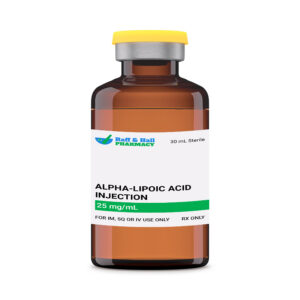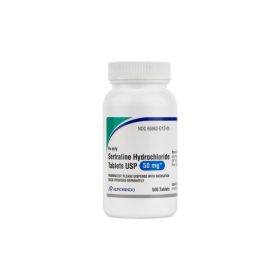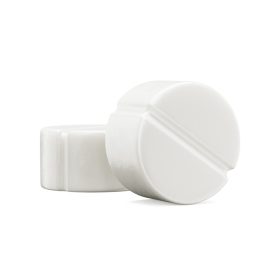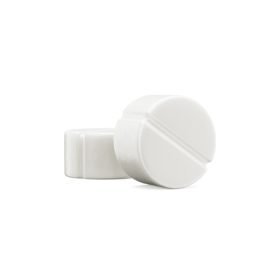Anastrozole Capsule (Each)
Anastrozole Tablet (Each)
Anastrozole Tablet (Each) †
† commercial product
Summary: Clinical Use and Background of Selected Medications
Bupropion HCl
Bupropion is an atypical antidepressant in the aminoketone class. It’s not chemically related to tricyclics or SSRIs and is notable for having stimulant-like properties. It carries a higher risk of seizures than other antidepressants, especially at higher doses or in predisposed patients. Approved in 1985 but briefly pulled from the market, it was reintroduced in 1989 as Wellbutrin for depression, and later as Zyban for smoking cessation. It’s used off-label for conditions such as ADHD, neuropathic pain, and smokeless tobacco addiction. Several extended-release versions (Wellbutrin SR, XL, and Aplenzin) are FDA-approved for depression and seasonal affective disorder (SAD).
Phentermine HCl
Its pharmacology resembles amphetamines. First FDA-approved in 1959 (resin form) and then in 1973 (HCl form), it gained popularity in the 1990s in combination with fenfluramine (Fen-Phen), which was later withdrawn due to valvular heart disease and pulmonary hypertension. Solo phentermine remains FDA-approved, including the orally disintegrating tablet Suprenza. Long-term safety data is limited, and combining with other anorectics is not recommended.
Topiramate
Topiramate is a broad-spectrum anticonvulsant used for seizures (partial, generalized, and Lennox-Gastaut syndrome) and migraine prevention. It works through multiple mechanisms, including inhibiting excitatory neurotransmission. Off-label, it’s used for binge eating disorder, Tourette’s, and substance abuse disorders.
Naltrexone HCl
It’s most effective when used in structured treatment programs. Available orally and as a monthly injection (Vivitrol), it’s not useful for acute withdrawal and won’t prevent it. Naltrexone has limited efficacy in some alcoholic patients but can reduce cravings and relapse. Ultrarapid detox techniques using naltrexone remain controversial and unstandardized.
Methylcobalamin
Methylcobalamin is a bioactive form of vitamin B12 used in deficiency states like pernicious anemia or malabsorption.
Caffeine
Caffeine is a CNS and respiratory stimulant found in many foods and medications. Clinically, it’s used for apnea of prematurity in neonates and is often included in migraine treatments or over-the-counter fatigue relievers. Caffeine is preferred over theophylline in neonates due to its longer half-life and better safety profile.
Oxytocin
Oxytocin is a pituitary hormone used primarily to induce labor and control postpartum bleeding. It also plays a role in milk let-down and maternal bonding. Though no longer used intranasally, it continues to be studied for social and behavioral effects in conditions like autism.
Metformin
Metformin is the first-line oral treatment for type 2 diabetes, with benefits including weight neutrality, cardiovascular protection, and low risk of hypoglycemia. It’s also used for polycystic ovary syndrome (PCOS) and has shown promise in delaying puberty and menarche in certain cases. Multiple formulations exist, including extended-release options to improve tolerability.
Anastrozole prevents aromatase, the enzyme that catalyzes the ultimate step in estrogen synthesis. Less likely to show agonist or antagonist steroidal effects, anastrozole is an oral, competitive, nonsteroidal aromatase inhibitor. The main source of circulating estrogens in postmenopausal women is the transformation of adrenal and ovarian androgens (androstenedione and testosterone) to estrogens (estrone and estradiol) by peripheral aromatase. Inhibition of aromatase might provide a more thorough estrogen block than surgical ablation. Aromatase inhibition by anastrozole is more easily done at extraglandular sites than it is at premenopausal ovaries. One approach to starve the tumor of estrogens and limit tumor growth is by stopping the synthesis of estrogens. Estradiol plasma levels decline roughly 80% from baseline with regular anastrozole treatment. Aromatase inhibitors could also reduce the production of estrogen at the tumor cell. Tumor estradiol synthesis could be minimal, though, given the apparently minimal aromatase activity.
Your health care practitioner has to be informed of any of the following: heart disease, circulation difficulties, a history of stroke or blood clot, high cholesterol, osteoporosis, low bone mineral density, or advanced liver disease. Taking an estrogen drug, such as hormone replacement therapy, estrogen creams, or tamoxifen, with anastrozole may cause it not to function well. Anastrozole may need to be continued for up to five years.
Generally speaking, premenopausal women should not use anastrozole as it might not be able to suppress the production of estrogen from the ovaries and Therefore, while it has been used . Concurrent treatment with hormone replacement therapy (i.e., exogenous estrogens) should not be given with anastrozole.
Mild to moderate hepatic impairment patients should use anastrozole with care and be carefully monitored for adverse effects. For patients with hepatic impairment, no dosage changes are advised as plasma anastrozole levels stay inside the range of normal patients. No patients with severe hepatic damage have undergone investigations.
Particularly in, during anastrozole treatment, patients should be watched for symptoms of osteoporosis including low bone mineral density (BMD). patients with prior osteoporosis, osteopenia, or risk factors for the onset of osteoporosis. Following a median 68 months’ follow-up in the ATAC study, the odds of bone fractures in people taking anastrozole were dramatically raised relative to Patients using tamoxifen (11% for anastrozole vs. 7.7% for tamoxifen, OR 1.49, 95% CI 1.25–1.77, P < 0.0001). Also, in the combined investigation of the After a median follow-up of 36 months, the odds of bone fractures in patients taking anastrozole were Anastrozole should be taken cautiously by women already ischemic heart illness. (2% for anastrozole vs. 1% for tamoxifen, OR 2.14, 95% CI 1.14–4.17, P = 0.015). of patients in the whole study sample).
Per the manufacturer, it is unlikely that anastrozole administered at the recommended dose will inhibit the metabolism of cytochrome P450mediated drugs given concurrently.
Anastrozole did not change the warfarin pharmacokinetics (Cmax or AUC) in a male volunteer study (n=16), nor did it affect warfarin anticoagulant activity as Measured by prothrombin time, activated partial thromboplastin time, and thrombin time of both R and Swarfarin.
Tamoxifen and anastrozole should not be given simultaneously. Pharmacokinetic and clinical data from the ATAC study show that simultaneous administration of anastrozole and tamoxifen lowers anastrozole plasma levels by 27% relative to outcomes attained with anastrozole only.
Anastrozole treatment seeks to reduce circulating estrogen levels and stop the growth of hormonally responsive tumors. Anastrozole’s pharmacologic activity could be hampered by any estrogens or estrogen-containing medications, including combined oral contraceptives, therefore it should not be administered along with any. Moreover frequent in women undergoing long-term aromatase inhibitor treatment; atrophic vaginitis brought on by aromatase inhibitor medication Occasionally treated with vaginal estrogen since the systemic exposure of estrogen from vaginal products is thought to be modest. Estrogen levels increased noticeably after the addition of vaginally given estrogen for atrophic vaginitis in a recent study of 7 women on aromatase inhibitor therapy. At 2 weeks, estrogen levels rose from a mean baseline of < 5 pmol/l to 72 pmol/l, and at 4 weeks, they fell to < 35 pmol/l. Even if the research was limited, estrogen levels shot up dramatically in 6/7 individuals. Clinicians should know that vaginal estrogen preparations may raise serum estrogen levels; alternate therapies for atrophic vaginitis in patients taking aromatase inhibitors should be examined. Androstenedione is a crucial metabolic precursor for androgens and estrogens in both men and women. Since androstenedione could interfere with the pharmacologic activity of the aromatase inhibitor, androstenedione supplements should not be taken at the same time as any aromatase inhibitors. Aromatase inhibitors (aminoglutethimide, anastrozole, exemestane, letrozole, testolactone, vorozole) can on the other hand impair biotransformation of androstenedione in both sexes; the enzyme aromatase converts androstenedione to estrone.
Weakness in your hand or wrist; numbness; tingling; cold sensation; trouble with your fingers when gripping; hot flashes; joint pain or stiffness; despair; mood. adjustments, sleep difficulties (insomnia), cough, sore throat, thinning hair, slight nausea, vomiting, back pain, bone pain
The most often reported side effect linked with anastrozole during clinical studies were hot flashes (11–36%). Other frequently reported negative reactions during controlled trials included vaginal irritation (i.e., dryness) (1—2%), vaginal bleeding (1—5%), vaginal discharge (4%), vaginitis (4%), and vulvovaginitis (6%). Mostly in the first few weeks following switching from current hormonal therapy to anastrozole therapy, vaginal bleeding happens. Further assessment ought to be taken into account should the bleeding continue.
Up to a third of patients undergoing anastrozole in clinical studies experienced gastrointestinal/digestive side effects. Abdominal pain (6–9%), anorexia (5–8%), constipation (7–9%), diarrhea (7–9%), dyspepsia (7%), nausea (11–20%), vomiting (8–13%), and xerostomia or dry mouth (4–6%) were among these responses. Two to nine percent of patients using anastrozole reported weight gain, but this happened less often than with megestrol (12%). Furthermore, with or without jaundice (< 0.01%), 2–5% of anastrozole users also lost weight and had increased hepatic enzymes. Elevations in hepatic enzymes—mostly serum gamma glutamyl transferase (GGT)—were noted in patients with liver metastases treated with anastrozole or megestrol. Although other influencing elements cannot be discounted, the advancement of liver disease in these patients most probably caused these changes. During postmarketing use of anastrozole with an estimated incidence of >= 0.1% to < 1%, hepatitis and hyperbilirubinemia have been noted. Postmarket reports are voluntary, hence it is impossible to determine a definite incidence or causal link. Among the nervous system adverse reactions linked to the use of anastrozole in clinical trials are anxiety (2–6%), disorientation (2–5%), depression (2–13%), dizzines Hypertonia (3%), insomnia (2—10%), lethargy (1%), malaise (2—5%), anxiety (2—5%), and paresthesias (5—7%) are all potential effects of anastrozole administration.12 Thromboembolic development has been linked with anastrozole use. Occurrences of thromboembolism in patients treated with anastrozole during clinical tests were reported to be 2–4 percent. The incidence of anastrozole-associated thrombosis was lower than that described with tamoxifen (2–6%) or megestrol (5%). Specific cases included angina (2.3—11.6%), cerebrovascular accident (stroke) particularly cerebral ischemia and cerebral infarct (2%), myocardial infarction (0.9—1.2%), myocardial ischemia (< 4%), pulmonary embolism (< 4%; retinal thrombosis, < 4%; thrombophlebitis 2—5%. Women with pre-existing ischemic cardiac disease had a 17% incidence of ischemic cardiac in the ATAC experiment. events.
Under FDA pregnancy risk category X, anastrozole is not advised for women who are pregnant or might get pregnant. Anastrozole raises pregnancy loss both before and following implantation, as animal experiments show. Although there is no evidence of teratogenicity, it crosses the placenta and causes fetal damage, including delayed fetal development. Anastrozole is only approved for postmenopausal women and should usually not be utilized; there have been no satisfactory studies in pregnant women. employed in women of childbearing capacity. Should pregnancy happen, though, while the patient is taking anastrozole, she should be advised on the potential damage to the baby and possible loss of pregnancy.
It is unknown whether anastrozole passes through breast milk. Given that numerous medications are excreted in human milk and given the demonstrated tumorigenicity for anastrozole in animal studies or the possible for significant side effects, Considering the significance of the medication to the mother, a decision should be made whether to stop breastfeeding or to stop the drug for reactions in nursing infants. Premenopausal women should not use anastrozole, therefore use during lactation would not be anticipated.
Store this medication at 68°F to 77°F (20°C to 25°C) and away from heat, moisture and light. Keep all medicine out of the reach of children. Throw away any unused medicine after the beyond use date. Do not flush unused medications or pour down a sink or drain.
- Winer EP, Hudis C, Burnstein HJ, et al. American Society of Clinical Oncology technology assessment on the use of aromatase inhibitors as adjuvant therapy for postmenopausal women with hormone receptor-positive breast cancer: status report 2004. J Clin On
- The ATAC (Arimidex, Tamoxifen Alone or in Combination) Trialists’ Group. Results of the ATAC (Arimidex, Tamoxifen, Alone or in Combination) trial after completion of 5 years’ adjuvant treatment for breast cancer. Lancet 2005;365:60-62.
- The Arimidex, Tamoxifen, Alone or in Combination (ATAC) Trialists’ Group. Effect of anastrozole and tamoxifen as adjuvant treatment for early-stage breast cancer: 100-month analysis of the ATAC trial. Lancet Oncol 2008;9:45-53.
- Boccardo F, Rubagotti A, Puntoni M, et al. Switching anastrozole versus continued tamoxifen treatment of early breast cancer: preliminary results of the Italian tamoxifen anastrozole trial. J Clin Oncol 2005;23:5138-47.
- Jonat W, Gnant M, Boccardo F, et al. Effectiveness of switching from adjuvant tamoxifen to anastrozole in postmenopausal women with hormone-sensitive early-stage breast cancer: a meta-analysis. Lancet Oncol 2006;7:991-6.
- Goss PE, Gwyn KMEH. Current perspectives on aromatase inhibitors in breast cancer. J Clin Oncol 1994;12:2460-70.
- Plourde PV, Dyroff M, Dukes M. Arimidex(R): A potent and selective fourth-generation aromatase inhibitor. Breast Cancer Res Treat 1994;30:103-11.
- Bradlow HL. A reassessment of the role of breast tumor aromatization. Cancer Res 1982;3382-6.
- Arimidex (anastrozole) package insert. Wilmington DE: AstraZeneca Pharmaceuticals LP; 2013 May.
- Varelas FK, Papanicolaou AN, Vavasti-Christaki N, et al. The effect of anastrazole on symptomatic uterine leiomyomata. Obstet Gynecol 2007;110:643-9.
- Jakesz R, JOnat W, Gnant M, et al. Switching of postmenopausal women with endocrine-responsive early breast cancer to anastrozole after 2 years’ adjuvant tamoxifen: combined results of ABCSG trial 8 and ARNO 95 trial. Lancet 2005;366:455-62.
- Arimidex (anastrozole) package insert. Wilmington DE: AstraZeneca Pharmaceuticals LP; 2009 Apr.
- Arimidex® (anastrozole) package insert. Wilmington DE: AstraZeneca Pharmaceuticals LP; 2002 Oct.
- The ATAC (Arimidex, Tamoxifen Alone or in Combination) Trialists’ Group. Anastrozole alone or in combination with tamoxifen versus tamoxifen alone for adjuvant treatment of postmenopausal women with early breast cancer: first results of the ATAC randomise
- Kendall A, Dowsett M, Folkerd E, et al. Caution: vaginal estradiol appears to be contraindicated in postmenopausal women on adjuvant aromatase inhibitors. Ann Oncol 2006;17:584—7.
- Kroboth PD, Slalek FS, Pittenger AL et al. DHEA and DHEA-S: a review. J Clin Pharmacol 1999;39:327—48.
- Aromasin® (exemestane) package insert. Kalamazoo MI: Pharmacia & Upjohn Company; 2005 Oct.
- Femara® (letrozole) package insert. East Hanover, NJ: Novartis Pharmaceuticals Corporation; 2003 Feb.
- Teslac (testolactone) package insert. Princeton, NJ: Mead-Johnson Oncology Products, Bristol-Myers Squibb, Co.; 1998 Dec.





